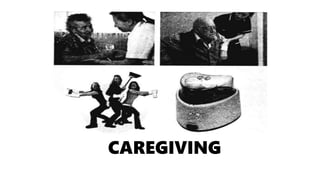
TLE 7 3RD QUARTER.pptx
- 1. CAREGIVING
- 2. Groupings What is caregiving for you ? 1. 2. 3. 4. 5.
- 3. Tools and Equipment According to Specific Jobs
- 9. Operating Caregiving Equipment, Tools and Paraphernalia Now that you have successfully identified the different equipment, tools, and paraphernalia used in providing health care, it is a must that you master the proper utilization of each. As an efficient and dependable caregiver, you must learn the procedures in operating them, since you will be expected to use them in your particular job.
- 10. Common Equipment in Meal Preparation 1. Blender 2. Coffee Maker 3. Food Processor 4. Microwave Oven
- 11. Common Equipment in Cleaning, Laundry, and Ironing 1. Flat Iron 2. Washing Machine
- 12. Common Equipment in Taking the Vital Signs A. Thermometer • Body temperature is a measurement of the amount of heat in the body. The balance between heat produced and heat lost is the body temperature. • The normal adult body temperature is 37 degrees Celsius. There is a normal range in which a person’s bodytemperature may vary and still be considered normal. Take a look at these normal ranges of body temperature: Oral : 36.4 to 37.2 degrees Celsius Rectal : 37 to 37.8 degrees Celsius Axillary : 35.9 to 36.7 degrees Celsius
- 14. 1. Clinical thermometer • may be inserted either into the rectum through the anus (rectal temperature), • into the mouth under the tongue (oral or sub-lingual) or armpit (axillary temperature). • It is made of glass with a narrowing above the bulb so that the mercury column stays in position even when the instrument is removed. The use of this type is now being eradicated as the mercury content is dangerous to people.
- 15. 2. Digital thermometer • may be inserted into the mouth under the tongue, under the armpit or into the anus. This thermometer displays the reading in the LCD. • This type of thermometer does not use mercury which is hazardous to humans. That is why more and more people are using it now. • Also, using this is simple, quick and effective.
- 16. 3. Ear digital thermometer • measures the heat coming from the eardrum. • This release of heat is converted into a temperature and displayed on an LCD. • It is very easy to use this. You just have to place the tip in the ear of a person, press the button and in a few seconds, the measurement is seen on the LCD.
- 17. 4. Infrared thermometer with laser pointer • measures temperature using thermal radiation emitted by the body. • It is also called laser thermometer if a laser is utilized to • aid in aiming the thermometer. • Others call it non-contact thermometer because of its ability to measure temperature from a distance. It provides temperature reading without physically touching the object. • All you have to do is aim at the object (as in the forehead), pull the trigger and immediately, you can see the temperature reading on the • LCD.
- 21. SHORT QUIZ
- 22. PERFORMANCE TASK 1 CREATE AN “ELDERLY CAREGIVING POSTER”
- 24. Calculations Using Ratios, Fractions, and Proportions RATIO – a quick way to compare numbers. It uses a colon between the numbers in relationship. Example: 3:6 2:8 FRACTION – It is the part of the whole or portion of a certain number. It uses a slash between numbers in the relationship. Example: ¾ 10/16
- 25. PROPORTION – An equation of two ratios which can be expressed as two fractions. The product of the mean is equal to the product of the extremes. Example: 2:6 = 5:x = 2x = 30 = x = 15 4:x = 2:8 = 2x = 32 = x = 16
- 26. Calculation of Drug Dosages • Ratios in proportion are used in calculating drug dosages. Rules to Remember when Calculating Drug Dosages 1. Use the correct units of measurement to avoid errors in calculating drug dosages. 2. Be careful in placing the decimal and zero. 3. Double check your answers.
- 28. EXAMPLE: 1. How many ml. of medicine are in two bottles if one bottle has 60 ml? 2. How many mg. of a drug are in 4 capsules if 3 capsules contain 1500 mg.?